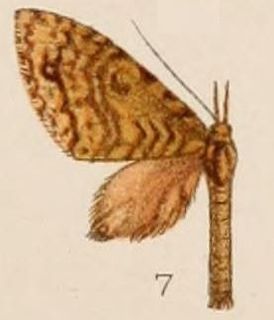
Baracus vittatus, the hedge-hopper, is a butterfly belonging to the family Hesperiidae. It is found in India and Sri Lanka.

Hippotion celerio, the vine hawk-moth or silver-striped hawk-moth, is a moth of the family Sphingidae. It was described by Carl Linnaeus in his 1758 10th edition of Systema Naturae.

Earias is a genus of moths in the monotypic subfamily Eariadinae of the family Nolidae. The genus was erected by Jacob Hübner in 1825. Species are found throughout Europe, Africa, Asia and Australia, some being agricultural pests such as bollworms.

Delgamma is a monotypic moth genus of the family Noctuidae erected by Frederic Moore in 1885. Its only species, Delgamma pangonia, the strawberry cutworm, was first described by Achille Guenée in 1852.

Aporandria is a monotypic moth genus in the family Geometridae described by Warren in 1894. Its single species, Aporandria specularia, was first described by Achille Guenée in 1857. It is found in Sri Lanka, India, Vietnam, Thailand, the Andamans, Peninsular Malaysia, Sumatra, Borneo, the Philippines and Sulawesi.

Sauris is a genus of moths in the family Geometridae erected by Achille Guenée in 1857.

Oreta extensa is a species of moth of the family Drepanidae described by Francis Walker in 1855. It is found in China, Taiwan, India, Sri Lanka, Indonesia and Thailand.

Callidrepana patrana is a moth in the family Drepanidae. It was described by Frederic Moore in 1866. It is found in Nepal, India, Cambodia, Sri Lanka, Thailand, mainland China, Japan and Taiwan.
Palpifer taprobanus is a moth of the family Hepialidae. It was described by Frederic Moore in 1887 and is found in Sri Lanka.
Scopula emissaria is a moth of the family Geometridae. It was described by Francis Walker in 1861. It is found in India, Sri Lanka, Myanmar, Vietnam, China, Korea, Japan, the Philippines, Sumatra, Java, Wallacea and Australia.
Gymnoscelis ectochloros is a moth in the family Geometridae. It was described by George Hampson in 1891. It is found in India and Sri Lanka according to Hampson.
Earias flavida is a moth of the family Nolidae. It was described by Cajetan Felder in 1861. It is found from the Indo-Australian tropics of India, Sri Lanka, Sumatra and Java to Samoa and Tonga.

Attacus taprobanis is a moth of family Saturniidae. It is native to southern India and Sri Lanka. This species is very similar in morphology to the much more widely distributed Attacus atlas. It was once considered a subspecies of A. atlas.
Episparis liturata is a moth of the family Noctuidae first described by George Hampson in 1893. It is found in India, Sri Lanka, Java, Borneo, Myanmar, China and Thailand.
Goniocraspedon mistura is a moth of the family Noctuidae first described by Charles Swinhoe in 1891. It is found in India, Sri Lanka and Australia.

Idaea purpurea is a moth of the family Geometridae first described by George Hampson in 1891. It is found in India, Sri Lanka, Taiwan, the Andaman Islands, Peninsular Malaysia and Borneo.
Metorthocheilus emarginata, or Chundana emarginata, is a moth of the family Uraniidae first described by George Hampson in 1891. It is found in the Indian subregion, Sri Lanka, Taiwan, Borneo, Java and Seram.
Acidon nigribasis is a moth of the family Erebidae first described by George Hampson in 1895. It is found in India, Sri Lanka, and Borneo.

Earias cupreoviridis, called the cupreous bollworm as a larva, is a moth of the family Nolidae. The species was first described by Francis Walker in 1862. It is found in African countries like Botswana, the Democratic Republic of the Congo, Eritrea, Ethiopia, the Gambia, Kenya, Nigeria, Sierra Leone, South Africa, Togo, Uganda, Zimbabwe to Asian countries like India, Sri Lanka, China, Japan, Korea, Philippines, Indonesia and Hong Kong.

Xenochroa chlorostigma is a moth of the family Nolidae first described by George Hampson in 1893. It is found in India, Sri Lanka, Himalaya, Sundaland, Philippines and Sulawesi.











